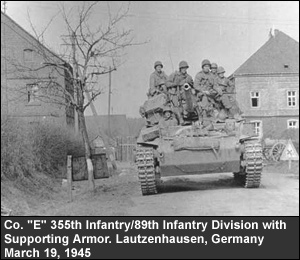 |
Moselle Crossing: The Assault

A dense fog hung over the river on morning of March 15 as the assault Companies closed into their positions and found cover. The intensity of German fire increased as the fog lifted, and several artillery observers were wounded by harassing motor, rocket, 88mm and machine-gun fire from the opposite heights while securing shell reports during the afternoon. Fire was exchanged across the river and during the night patrols were sent to probe. By midnight the stage was set for the Division's first major test. Tense 89ers crouched in cellars, buildings and undergrowth along the riverbank. At 0330, March 16, the first riflemen slipped from the shadows, climbed into the boats and silently paddled across the river. The initial three waves crossed at one-hour intervals; first riflemen, followed by heavy weapons and antitank crews. By dawn, three rafts at Alf and three at Aldegund were ferrying vehicles and 4.2-inch mortars. The 354th went over without drawing a shot, while the 353rd received only light sniper fire.
 The crossing had caught the Germans by surprise. The 3rd Battalion, 354th, dug into the eastern hillside near Burg, when at 0830 the Germans opened with sniper and motor fire on Companies L, and I and raked the crossing with their machine guns. The 133rd Engineering Battalion was forced to temporarily stop ferrying vehicles. Upstream three hundred yards the Battalion A&P Platoon kept the ammunition moving. Riflemen still firing from the west bank were silenced by a platoon of tank destroyers. While Company L set up a base of fire, Company K worked its way up close to Burg, then split: one force entered the village by the railroad tracks, the other from the vineyards above. Within five minutes white flags of surrender hung from every window. One hour later all three battalions of the 354th were over, and communications were functioning.
The crossing had caught the Germans by surprise. The 3rd Battalion, 354th, dug into the eastern hillside near Burg, when at 0830 the Germans opened with sniper and motor fire on Companies L, and I and raked the crossing with their machine guns. The 133rd Engineering Battalion was forced to temporarily stop ferrying vehicles. Upstream three hundred yards the Battalion A&P Platoon kept the ammunition moving. Riflemen still firing from the west bank were silenced by a platoon of tank destroyers. While Company L set up a base of fire, Company K worked its way up close to Burg, then split: one force entered the village by the railroad tracks, the other from the vineyards above. Within five minutes white flags of surrender hung from every window. One hour later all three battalions of the 354th were over, and communications were functioning.
By noon, five infantry battalions had crossed the Moselle and were consolidating. CT 4 carved a bridgehead a kilometer and a half deep. CT 3 pushed through Bullay unopposed, drove ahead three kilometers and sent patrols into Grenderich. Small combat groups of Company C. 353rd, outflanked a series of German delaying positions, charged the final 1,500 yards over exposed ground in the face of small-arms fire and seized the town, killing or capturing eighty-five Germans. Engineers swept the road from Bullay to Zell for a distance of three miles, and infantry quickly cleared this section of bank of snipers so that construction of the pontoon bridge could get underway.
Page 1 |
Page 2 | Page 3 |
Page 4 | Page 5 |
Page 6 | Page 7 |
Page 8
|
 |


 The crossing had caught the Germans by surprise. The 3rd Battalion, 354th, dug into the eastern hillside near Burg, when at 0830 the Germans opened with sniper and motor fire on Companies L, and I and raked the crossing with their machine guns. The 133rd Engineering Battalion was forced to temporarily stop ferrying vehicles. Upstream three hundred yards the Battalion A&P Platoon kept the ammunition moving. Riflemen still firing from the west bank were silenced by a platoon of tank destroyers. While Company L set up a base of fire, Company K worked its way up close to Burg, then split: one force entered the village by the railroad tracks, the other from the vineyards above. Within five minutes white flags of surrender hung from every window. One hour later all three battalions of the 354th were over, and communications were functioning.
The crossing had caught the Germans by surprise. The 3rd Battalion, 354th, dug into the eastern hillside near Burg, when at 0830 the Germans opened with sniper and motor fire on Companies L, and I and raked the crossing with their machine guns. The 133rd Engineering Battalion was forced to temporarily stop ferrying vehicles. Upstream three hundred yards the Battalion A&P Platoon kept the ammunition moving. Riflemen still firing from the west bank were silenced by a platoon of tank destroyers. While Company L set up a base of fire, Company K worked its way up close to Burg, then split: one force entered the village by the railroad tracks, the other from the vineyards above. Within five minutes white flags of surrender hung from every window. One hour later all three battalions of the 354th were over, and communications were functioning.